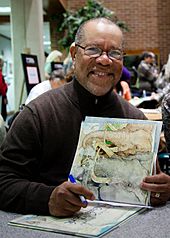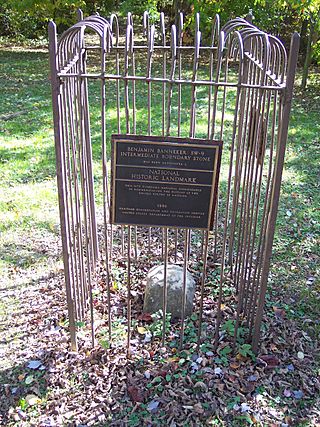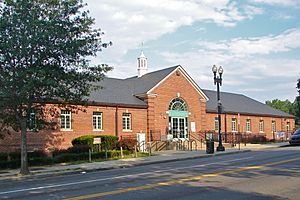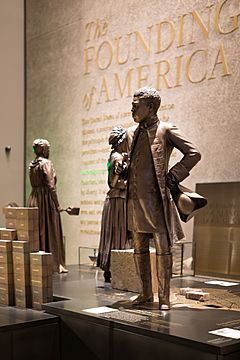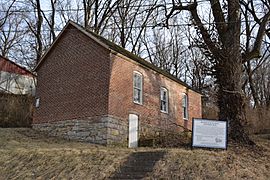Commemorations of Benjamin Banneker facts for kids
Benjamin Banneker was a brilliant free African American who lived from 1731 to 1806. He was known for many things, including writing an almanac, being a surveyor, a landowner, and a farmer. He had amazing knowledge of mathematics, astronomy, and natural history.
Many places and things in the United States are named after Benjamin Banneker to remember his important work. These include postage stamps, parks, schools, and streets. Even a famous poet, Rita Dove, wrote a poem about him in 1983.
Contents
- Benjamin Banneker Postage Stamp
- Places to Visit and Learn
- Schools and Learning Places
- Scholarships and Awards
- Streets and Roads
- Buildings and Homes
- Businesses and Organizations
- Groups Working for Change
- Other Ways Benjamin Banneker is Remembered
- See also
Benjamin Banneker Postage Stamp
On February 15, 1980, the United States Postal Service released a special 15-cent postage stamp honoring Benjamin Banneker. This happened during Black History Month in Annapolis, Maryland. The stamp showed a picture of Banneker with a small telescope.
This stamp was the third in a series called the Black Heritage stamp series. The artist, Jerry Pinkney, designed the portrait. Since no real pictures of Banneker exist, the artist imagined what he might have looked like.
Places to Visit and Learn
Many parks, museums, and community centers are named after Benjamin Banneker. These places help people learn about his life and achievements.
Parks to Explore
Benjamin Banneker Historical Park and Museum, Maryland
This park is located in Oella, Maryland, where Banneker's farm and home used to be. It's a beautiful woodland area between Ellicott City and Baltimore. The park opened on June 9, 1998.
The park covers 138 acres and has archaeological sites and nature trails. It's the largest original African American historical site in the U.S. The main part of the park is a museum that shows Banneker's contributions.
The museum has a visitors center with Banneker's works and artifacts. There's also a community gallery, a gift shop, and a patio garden. An old stone farmhouse from the 1850s, called the "Molly Banneky House," is also on the grounds.
In 2009, a replica of Banneker's log cabin was opened at the park. It was built to look like his original home. A historical marker also stands in the park, telling visitors about Banneker.
Pictures from Benjamin Banneker Historical Park and Museum
Benjamin Banneker Park and Memorial, Washington, D.C.

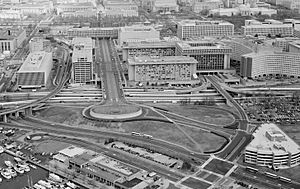
This 4.7-acre urban park in southwest Washington, D.C. honors Benjamin Banneker. It's located near the National Mall and offers great views. The park has a prominent overlook at the end of L'Enfant Promenade.
A traffic circle called Banneker Circle SW surrounds the overlook. The National Park Service manages this park. A historical marker was placed near the entrance in 1997.
The park was designed by landscape architect Daniel Urban Kiley and opened in 1969. It was officially renamed "Benjamin Banneker Park" in 1971. The park's centerpiece is a large fountain that shoots water high into the air.
The park was rededicated in 1997 after a restoration. It's an important public space named after an African American. In 2017, plans were approved to add a staircase and ramp connecting the park to Washington's Southwest Waterfront. This project was finished in 2018.
Benjamin Banneker Park, Arlington County, Virginia
This 11-acre park in Arlington County, Virginia, also remembers Banneker. It highlights his work in surveying the boundaries of Washington, D.C. The park has paved trails, picnic tables, a playground, and a dog park. One of the original boundary markers of D.C. is located within this park.
Playgrounds for Fun
Banneker Playground, Brooklyn, New York
The Banneker Playground in Brooklyn, New York, was built in 1937. In 1985, it was renamed to honor Benjamin Banneker. This 1.67-acre playground has handball and basketball courts, trees, and a camel sculpture. The Benjamin Banneker Elementary School (P.S. 256) is nearby.
Community Centers for Everyone
Banneker Community Center, Catonsville, Maryland
This community center in Catonsville, Maryland, is close to where Banneker's home used to be. It has ballfields, multipurpose courts, and a playground for the community.
Banneker Community Center, Washington, D.C.
Located near Howard University in northwest Washington, D.C., this center offers many activities. It has playing fields, basketball and tennis courts, a swimming pool, and a computer lab. Built in 1934, it was an important place for the black community in Washington, D.C.
Benjamin Banneker Community Center, Bloomington, Indiana
The Benjamin Banneker Community Center in Bloomington, Indiana, has a gym, kitchen, library, and family resource center. It used to be a segregated school for African American students from 1915 to 1951. In 1994, it was renamed to honor Benjamin Banneker and its history.
Museums to Visit
Banneker-Douglass Museum, Annapolis, Maryland
This museum in Annapolis, Maryland, honors both Benjamin Banneker and Frederick Douglass. It is Maryland's official museum of African American heritage. It opened on February 24, 1984, and is located in a historic church building.
Smithsonian National Museum of African American History and Culture, Washington, D.C.
The Smithsonian Institution's National Museum of African American History and Culture in Washington, D.C., opened in 2016. It has a statue of Benjamin Banneker in an exhibit about "The Founding of America."
Planetariums for Stargazing
Banneker Planetarium, Catonsville, Maryland
The Banneker Planetarium in Catonsville, Maryland, is a great place to learn about stars and space. It's part of the Community College of Baltimore County and offers shows to the public.
Schools and Learning Places
Many schools and university buildings across the United States are named after Benjamin Banneker.
University Buildings and Programs
- Banneker Hall, Morgan State University, Baltimore, Maryland
- Benjamin Banneker Hall, Tuskegee University, Tuskegee, Alabama
- Benjamin Banneker Hall, University of Maryland Eastern Shore, Princess Anne, Maryland
- Benjamin Banneker Honors College, Prairie View A&M University, Prairie View, Texas
- Benjamin Banneker Memorial Sundial, Howard University, Washington, D.C.
- Benjamin Banneker Room, Adele H. Stamp Student Union, University of Maryland, College Park, Maryland
- Benjamin Banneker Science Hall, Central State University, Wilberforce, Ohio
- Benjamin Banneker Technology Complex, Florida Agricultural and Mechanical University, Tallahassee, Florida
High Schools
- Benjamin Banneker Academic High School, Washington, D.C.
- Benjamin Banneker Academy for Community Development, Brooklyn, New York
- Benjamin Banneker High School, Fulton County, Georgia
- Benjamin Banneker Lecture Hall, Baltimore Polytechnic Institute, Baltimore, Maryland
Middle Schools
- Benjamin Banneker Charter Public School, Cambridge, Massachusetts
- Benjamin Banneker Middle School, Burtonsville, Maryland
- The Benjamin Banneker Preparatory Charter School, Willingboro, New Jersey
Elementary Schools
- Banneker Group (23 elementary schools), St. Louis, Missouri
- Banneker-Doyle Career and Transition Center, Los Angeles, California
- Banneker Elementary School, St. Louis, Loudoun County, Virginia
- Banneker Elementary Science & Technology Magnet School, Kansas City, Kansas
- Benjamin Banneker Academy, East Orange, New Jersey
- Benjamin Banneker Achievement Center, Gary, Indiana
- Benjamin Banneker Charter Academy of Technology, Kansas City, Missouri
- Benjamin Banneker Elementary School, Chicago, Illinois
- Benjamin Banneker Elementary School, Kansas City, Missouri
- Benjamin Banneker Elementary School, Loveville, Maryland
- Benjamin Banneker Elementary School, Milford, Delaware
- Benjamin Banneker Elementary School, New Orleans, Louisiana
- Benjamin Banneker School (now Benjamin Banneker Community Center), Bloomington, Indiana
- Benjamin Banneker Elementary School (P.S. 256), Brooklyn, New York
- Benjamin Banneker School, Parkville, Missouri (historical)
Other Educational Places
- Benjamin Banneker Institute, Philadelphia, Pennsylvania (historical)
Scholarships and Awards
Several university scholarships and awards are named after Banneker, helping students achieve their goals.
Scholarships
- Benjamin Banneker Professorship of American Studies and History, Columbian College of Arts and Sciences, George Washington University, Washington, D.C.
- Benjamin Banneker Scholarship Program, Central State University, Wilberforce, Ohio
- Banneker/Key Scholarship, University of Maryland Honors College, College Park, Maryland
Awards
- Benjamin Banneker Award, Alabama Agricultural and Mechanical University, Huntsville, Alabama
- Benjamin Banneker Award, Temple University College of Education, Philadelphia, Pennsylvania
- Benjamin Banneker Award for Excellence in Math and Science, Metropolitan Buffalo Alliance of Black School Educators, Buffalo, New York
- Benjamin Banneker Award for Outstanding Social Commitment and Community Initiatives, American Planning Association, National Capital Area Chapter, Washington, D.C.
- Benjamin Banneker Legacy Award, The Benjamin Banneker Institute for Science and Technology, Washington, D.C.
Streets and Roads
You can find streets named after Banneker in many cities, showing his lasting impact.
- Banneker Avenue, Richmond Heights, Missouri
- Banneker Avenue North, Minneapolis, Minnesota
- Banneker Court, Detroit, Michigan
- Banneker Court, Mobile, Alabama
- Banneker Court, Stone Mountain, Georgia
- Banneker Court, Wilmington, Delaware
- Banneker Cove, Memphis, Tennessee
- Banneker Drive, San Diego
- Banneker Drive, Williamsburg, Virginia
- Banneker Drive Northeast, Washington, D.C.
- Banneker Lane, Annapolis, Maryland
- Banneker Place, Dallas, Texas
- Banneker Place, Nipomo, California
- Banneker Road, Columbia, Maryland
- Banneker Street, Columbus, Ohio
- Banneker Street, DeQuincy, Louisiana
- Benjamin Banneker Boulevard, Aquasco, Maryland
- South Banneker Avenue, Fresno, California
- West Banneker Street, Hanford, California
Buildings and Homes
Some buildings and apartment complexes are also named in Banneker's honor.
- Banneker Building, Columbia, Maryland
- Banneker Gardens, Cumberland, Maryland (townhomes/apartments)
- Banneker Homes, San Francisco
- Banneker Place, Town Center, Columbia, Maryland
- Banneker Place apartments, Washington, D.C.
Businesses and Organizations
Several businesses and groups carry Banneker's name, often focusing on science, technology, or community work.
- Banneker Energy, LLC, Duluth, Georgia and New Orleans, Louisiana (transportation fuel management)
- Banneker, Inc., Denver, Colorado (watches and clocks)
- Banneker Industries, Inc., North Smithfield, Rhode Island (supply chain management)
- Banneker Ventures, LLC, Washington, D.C. and Rockville, Maryland (design, construction and contracting management)
- The Banneker Group, LLC, Laurel, Maryland (general contracting and facility maintenance)
Groups Working for Change
Advocacy groups also use Banneker's name to inspire their work for justice and progress.
- The Benjamin Banneker Association, Inc. (BANNEKERMATH.org), Philadelphia, Pennsylvania
- The Benjamin Banneker Center for Economic Justice and Progress, Baltimore, Maryland
- The Benjamin Banneker Foundation, Fulton, Maryland
- The Benjamin Banneker Institute for Science & Technology, Washington, D.C.
- Washington Interdependence Council: Administrators of the Benjamin Banneker Memorial and Banneker Institute of Math & Science, Washington, D.C.
Other Ways Benjamin Banneker is Remembered
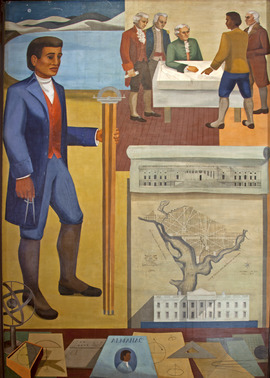
- "Banneker", a 1983 poem by Rita Dove (a former United States Poet Laureate)
- Banneker City Little League, Washington, D.C. (youth baseball)
- Banneker Institute, Cambridge, Massachusetts (a summer program in astronomy)
- Banneker Literary Institute, Philadelphia, Pennsylvania (historical)
- Banneker neighborhood, Town Center, Columbia, Maryland
- Benjamin Banneker 1731-1806: His Life and Place. An exhibition at the Corcoran Gallery of Art, Washington, D.C., in 1997.
- Benjamin Banneker Honors Math & Science Society, Washington Metropolitan Area: Washington, D.C., Virginia and Maryland
- Benjamin Banneker Mathematics Competition, Pittsburgh, Pennsylvania
- Benjamin Banneker mural, Recorder of Deeds Building, Washington, D.C.
- Benjamin Banneker obelisk, Mount Gilboa Chapel, Oella, Maryland.
- Benjamin Banneker Science Fair, Delaware Valley: Delaware, Pennsylvania and New Jersey
- Benjamin Banneker: SW-9 Intermediate Boundary Stone (milestone) of the District of Columbia: Arlington County and City of Falls Church, Virginia.
- Benjamin Banneker: The Man Who Loved the Stars (a 1981 film starring Ossie Davis)
- Benjamin Banneker: The Man Who Loved the Stars (a 1989 television docudrama starring Ossie Davis)
- The Banneker Room, George Howard Building, Howard County Government, Ellicott City, Maryland (County Council meeting room)
- The Banneker Room, The Wayside Inn, Ellicott City, Maryland (guest room)
See also


